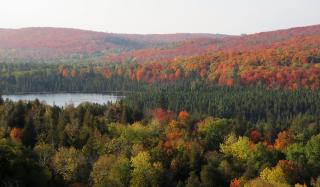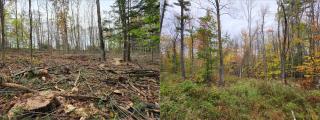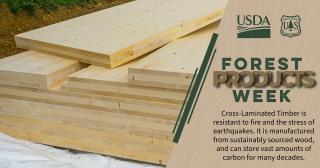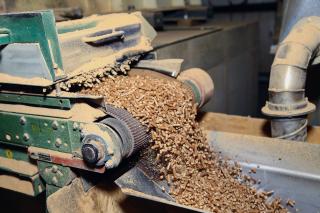Forest products support healthy forests
Celebrating National Forest Products Week
Brian Brashaw
Assistant Director, State, Private & Tribal Forestry, Wood Innovations
October 16, 2023

Fall colors on the Superior National Forest show a diverse forested landscape. (USDA Forest Service photo by Steve Robertsen)
When you work with wood products, every week is forest products week! But this week, October 15-21, 2023, is when we take a moment to celebrate National Forest Products Week and all the people who support the critical connection between forest products and forest management.
I grew up in a northern Wisconsin town, where the connection between forest products and healthy forests was apparent all around me. My dad worked for a hardwood lumber company. Family friends worked for both industry and the Forest Service. I saw firsthand how the forest products economy supports families.
My community was also surrounded by the stunning natural beauty of the region, and the love of our local forests ran deep, especially among the people who worked in the woods. These connections have stuck with me and guided my career.

The connection between healthy forested landscapes and the forest products economy has guided Brian Brashaw, Assistant Director of the Forest Service’s Wood Innovations program, throughout his career. (USDA Forest Service photo)
Now, as the lead for the Forest Service’s Wood Innovations program, I am proud of the work we’ve done with public and private sector partners to support market development and expand manufacturing for many sectors of the wood products economy. Together, we have strengthened markets for mass timber, softwood and hardwood lumber, renewable wood energy, biofuels, biochar, and other innovative wood products.
Healthy forests depend on a healthy forest products economy. The forest products economy and sustainably harvesting trees helps to facilitate really important forest management activities. Activities like thinning forest stands of unhealthy trees, promoting more biodiversity, and lowering the risk of a large wildfire.
The Forest Service and our partners are at the forefront of innovation, like using mass timber in construction. Mass timber is a new category of wood product that is changing how America builds. It is comprised of lumber or veneer that is glued together to produce strong, low-carbon cross-laminated timber panels or glulam beams. New mass timber buildings are incredible places to live, work and play.
Whether it is biomass energy or mass timber, a healthy and robust forest products industry is one of the indispensable tools for supporting forest management. Healthy markets for the full range of forest products are essential for a healthy industry. Simply put, strong markets for forest products improve forest health and resilience, and support clean water, clean air, wildlife habitat, recreation opportunities, and jobs in rural communities.

Sustainable harvests that thin forest stands allow them to regrow healthier and more diverse, which creates new habitat for wildlife like bears, deer and chickadees in the process. Depicted is a freshly harvested forest stand next to a stand that was harvested in the last five years. (USDA Forest Service photos by Korey Morgan)
The Forest Service continues to invest in the future of America’s wood products and wood energy economies through embracing innovation. This week we will announce the next round of funding opportunities for the Wood Innovations, Community Wood, and Wood Products Infrastructure Assistance grant programs.
Schools and private companies with wood processing facilities are eligible to apply. So too are organizations that support the forest and wood products sector while supporting the critical connection between healthy and resilient federal, state, tribal, and private forests. These organizations include tribes, states, associations and other non-government organizations that develop and support market innovation and expansion.

These grant programs have proven success. For instance, Forest Service Wood Innovations grants created strong momentum for mass timber construction. When we started focusing on mass timber in 2015, we had only a handful of buildings and no cross-laminated timber production in the U.S. Today, we have twelve new mass timber plants and over 1,860 mass timber projects that are in design or have been completed in all 50 states. This movement towards mass timber construction is creating new opportunities for using wood from forest restoration and supporting rural economies, all while embracing a construction material that is a superior carbon storing material.
Wood is used not only for construction, but also as a vital source of energy for families and communities. The 2018 Farm Bill catalyzed our grant programs, and since then, the Wood Innovation and Community Wood Energy grants have supported 45 wood energy projects that use hundreds of thousands of green tons of residues or chips annually. The Forest Service national wood energy technical assistance team provides critical support for over 50 wood energy projects annually to increase production and efficiency of heat and combined heat and power. We’re also expanding our efforts to accelerate new technologies and markets like biofuels and biochemicals, products that support sustainable forestry.
Renewable wood energy creates markets for low grade biomass from hazardous fuel treatment, harvesting, and industrial residues. National Bioenergy Day provides an opportunity to appreciate the importance of renewable wood energy.

Biomass like woodchips and wood pellets are used to heat homes, schools, hospitals, and other buildings, and to generate electricity. This woody biomass creates new revenue streams from low quality wood, which supports sustainable forestry operations and local forest products economies. (Photo courtesy Pellet Fuels Institute)
It’s not all about celebrating wood products this week, it’s also about celebrating the people who manage forests, harvest trees, manufacture wood products and produce wood energy. The hundreds of public and private wood products partnerships are the backbone of the growth and advances occurring in this industry.
It is an exciting time to be in the forest products industry, and I hope you join me in celebrating forest products this week and every week.